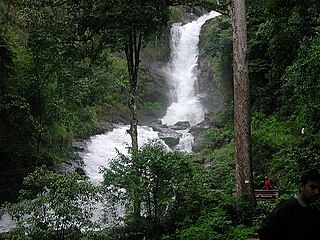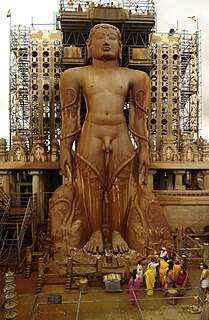
The Krishna River is a river in the Deccan plateau and is the third-longest river in India, after the Ganges and Godavari. It is also the fourth-largest in terms of water inflows and river basin area in India, after the Ganges, Indus and Godavari. The river, also called Krishnaveni, it is 1,400 kilometres (870 mi) long and its length in Maharashtra is 282 kilometres. It is a major source of irrigation in the Indian states of Maharashtra, Karnataka, Telangana and Andhra Pradesh.

The Godavari is India's second longest river after the Ganges river and drains into the third largest basin in India, covering about 10% of India's total geographical area. Its source is in Trimbakeshwar, Nashik, Maharashtra. It flows east for 1,465 kilometres (910 mi), draining the states of Maharashtra (48.6%), Telangana (18.8%), Andhra Pradesh (4.5%), Chhattisgarh (10.9%) and Odisha (5.7%). The river ultimately empties into the Bay of Bengal through an extensive network of tributaries. Measuring up to 312,812 km2 (120,777 sq mi), it forms one of the largest river basins in the Indian subcontinent, with only the Ganga and Indus rivers having a larger drainage basin. In terms of length, catchment area and discharge, the Godavari is the largest in peninsular India, and had been dubbed as the Dakshina Ganga.

Mandya is a city in the state of Karnataka. It is the headquarter of Mandya district and is located 45 kilometres (28 mi) from Mysore and 100 kilometres (62 mi) from Bangalore.

The Koyna River is a tributary of the Krishna River which originates in Mahableshwar, Satara district, western Maharashtra, India. It rises near Mahabaleshwar, a famous hill station in the Western Ghats. Unlike most of the other rivers in Maharashtra which flow East-West direction, the Koyna river flows in North-South direction. The Koyna River is famous for the Koyna Dam and the Koyna Hydroelectric Project. Koyna Hydroelectric Project is the 2nd largest completed hydroelectric project in India. The reservoir – Shivasagar Lake, is a huge lake of 50 km in length.

Krishna Raja Sagara, also popularly known as KRS, is a lake and the dam that creates it. They are close to the settlement of Krishna Raja Sagara in the Indian State of Karnataka. The gravity dam made of surki mortar is below the confluence of river Kaveri with its tributaries Hemavati and Lakshmana Tirtha, in the district of Mandya.

Mettur is an industrial and tourist town located in the Salem district in the state of Tamil Nadu, India. It is best known for the Mettur Dam which is the largest dam in south India.

The Vedavathi is a river in India. It rises from the Bababudanagiri Mountains of Western Ghats and flows through the states of Karnataka and Andhra Pradesh. The Vedavathi is also called the Hagari in Bellary District of Karnataka and parts of Andhra Pradesh. Two rivers, the Veda and Avathi, arise in the eastern part of the Sahyadri Hill range in Bababudangiri mountain ranges, flow east, and join near Pura to form the Vedavathi River. From there the river flows through Kadur Taluk Of Chikkamagalur District. Then it enters Hosadurga Taluk, Hiriyur Taluk and Challakere Taluk of Chitradurga district, respectively.

The Bhima River is a major river in Western India and South India. It flows southeast for 861 kilometres (535 mi) through Maharashtra, Karnataka, and Telangana states, before entering the Krishna River. After the first sixty-five kilometers in a narrow valley through rugged terrain, the banks open up and form a fertile agricultural area which is densely populated.
Bilaspur is a town and a municipal council in Bilaspur district in the Indian state of Himachal Pradesh.

Bilaspur is a district of Himachal Pradesh, India. Its capital is in the town of Bilaspur. The district has an area of 1,167 km2, and a population of 381,956. As of 2011 it is the third least populous district of Himachal Pradesh, after Lahul and Spiti and Kinnaur.

The Mettur Dam is one of the largest dams in India and also the largest in Tamil Nadu, located across the river Kaveri where it enters the plains. Built in 1934, it took 9 years to complete. Maximum height and width of the dam are 214 and 171 feet, respectively. The dam receives inflows from its own catchment area, Kabini Dam and Krishna Raja Sagara Dams located in Karnataka. There is a park at the base of the dam called Ellis Park maintained by the Tamil Nadu Public Works Department. It provides irrigation and drinking water facilities for more than 12 districts of Tamilnadu and hence is revered as the life and livelihood-giving asset of Tamil Nadu.

The Lakshmana Tirtha is a river of Karnataka, India. It rises in Kodagu district and flows eastward. It joins the Kaveri in the Krishna Raja Sagara lake.

Nagarjuna Sagar Dam is a masonry dam across the Krishna River at Nagarjuna Sagar which straddles the border between Nalgonda district in Telangana and Palnadu district in Andhra Pradesh. The dam provides irrigation water to the Nalgonda, Suryapet, Krishna, NTR, Bapatla, Eluru, Palnadu, Khammam, West Godavari, Guntur, and Prakasam districts along with electricity generation.
Mauranipur is a town and a municipal board in Jhansi district state of Uttar Pradesh, India. It is located in the Jhansi District. It's a largest tehsil in India. This town was known for textile production, known in ancient times as Madhupuri. There are many temples in Mauranipur. People call it mini ayoddhya. Jalvihar Mela and Viman Yatra are the most famous events in Mauranipur. The Kedareshwar temple and the Saprar dam are located near Mauranipur.

The Hemavati is a river in southern India near Karnataka and an important tributary of the Kaveri.
Krishnarajasagara is a town in Mandya district in the Indian state of Karnataka.

Karnataka, the sixth largest state in India, has been ranked as the third most popular state in the country for tourism in 2014. It is home to 507 of the 3600 centrally protected monuments in India, the largest number after Uttar Pradesh. The State Directorate of Archaeology and Museums protects an additional 752 monuments and another 25,000 monuments are yet to receive protection. Tourism centres on the ancient sculptured temples, modern cities, the hill ranges, forests and beaches etc. Broadly, tourism in Karnataka can be divided into four geographical regions: North Karnataka, the Hill Stations, Coastal Karnataka and South Karnataka.

The Venugopala Swamy Temple located at Hosa Kannambadi, near Krishna Raja Sagara, is an example of Hoysala architecture in Karnataka, India. This temple was built in the 12th century AD around the same time as the Chennakesava Temple at Somanathapura, Mysore district.

Telkupi is a submerged location of archaeological interest in Purulia district of West Bengal, India. The area, along with most of the temples situated there, was submerged in 1959 as a consequence to the construction of a dam across Damodar river at Panchet in Dhanbad district, then in Bihar.

KRS Nisarga Township is a mega housing project by Karnataka Housing Board formed in northwestern Mysuru. KRS Nisagra was named as it is right next to the Krishna Raja Sagara - KRS dam location. The layout has 6,309 sites, 207 houses, 18 civic amenity site, 12 commercial complexes and 54 parks.
















